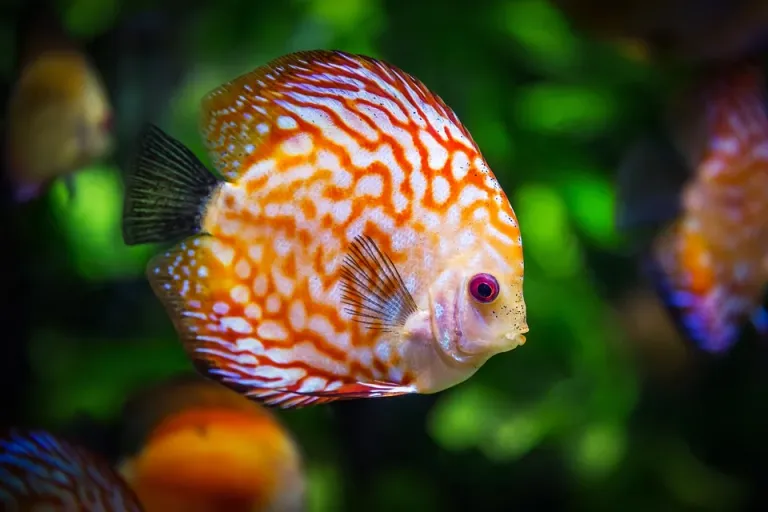
Fish are aquatic, craniate, gill-bearing animals that lack limbs with digits. Included in this definition are the living hagfish, lampreys, and cartilaginous and bony fish as well as various extinct related groups. Around 99% of living fish species are ray-finned fish, belonging to the class Actinopterygii, with over 95% belonging to the teleost subgrouping.
The earliest organisms that can be classified as fish were soft-bodied chordates that first appeared during the Cambrian period. Although they lacked a true spine, they possessed notochords which allowed them to be more agile than their invertebrate counterparts. Fish would continue to evolve through the Paleozoic era, diversifying into a wide variety of forms. Many fish of the Paleozoic developed external armor that protected them from predators. The first fish with jaws appeared in the Silurian period, after which many (such as sharks) became formidable marine predators rather than just the prey of arthropods.
Most fish are ectothermic ("cold-blooded"), allowing their body temperatures to vary as ambient temperatures change, though some of the large active swimmers like white shark and tuna can hold a higher core temperature.[1][2] Fish can acoustically communicate with each other, most often in the context of feeding, aggression or courtship.[3]
Fish are abundant in most bodies of water. They can be found in nearly all aquatic environments, from high mountain streams (e.g., char and gudgeon) to the abyssal and even hadal depths of the deepest oceans (e.g., cusk-eels and snailfish), although no species has yet been documented in the deepest 25% of the ocean.[4] With 34,300 described species, fish exhibit greater species diversity than any other group of vertebrates.[5]
Fish are an important resource for humans worldwide, especially as food. Commercial and subsistence fishers hunt fish in wild fisheries or farm them in ponds or in cages in the ocean (in aquaculture). They are also caught by recreational fishers, kept as pets, raised by fishkeepers, and exhibited in public aquaria. Fish have had a role in culture through the ages, serving as deities, religious symbols, and as the subjects of art, books and movies.
Tetrapods emerged within lobe-finned fishes, so cladistically they are fish as well. However, traditionally fish are rendered paraphyletic by excluding the tetrapods (i.e., the amphibians, reptiles, birds and mammals which all descended from within the same ancestry). Because in this manner the term "fish" is defined negatively as a paraphyletic group, it is not considered a formal taxonomic grouping in systematic biology, unless it is used in the cladistic sense, including tetrapods.[6][7] The traditional term pisces (also ichthyes) is considered a typological, but not a phylogenetic classification.
Etymology
The word for fish in English and the other Germanic languages (German Fisch; Gothic fisks) is inherited from Proto-Germanic, and is related to the Latin piscis and Old Irish īasc, though the exact root is unknown; some authorities reconstruct an Proto-Indo-European root *peysk-, attested only in Italic, Celtic, and Germanic.[8][9][10][11]
The English word once had a much broader usage than its current biological meaning. Names such as starfish, jellyfish, shellfish and cuttlefish attest to almost any fully aquatic animal (including whales) once being fish. "Correcting" such names (e.g. to sea star) is an attempt to retroactively apply the current meaning of fish to words that were coined when it had a different meaning.
Evolution
Main article: Evolution of fish
Fish, as vertebrata, developed as sister of the tunicata. As the tetrapods emerged deep within the fishes group, as sister of the lungfish, characteristics of fish are typically shared by tetrapods, including having vertebrae and a cranium.
Drawing of animal with large mouth, long tail, very small dorsal fins, and pectoral fins that attach towards the bottom of the body, resembling lizard legs in scale and development.Dunkleosteus was a gigantic, 10-metre (33 ft) long prehistoric fish of class Placodermi.
Lower jaw of the placoderm Eastmanosteus pustulosus, showing the shearing structures ("teeth") on its oral surface; from the Devonian of Wisconsin.
Early fish from the fossil record are represented by a group of small, jawless, armored fish known as ostracoderms. Jawless fish lineages are mostly extinct. An extant clade, the lampreys may approximate ancient pre-jawed fish. The first jaws are found in Placodermi fossils. They lacked distinct teeth, having instead the oral surfaces of their jaw plates modified to serve the various purposes of teeth. The diversity of jawed vertebrates may indicate the evolutionary advantage of a jawed mouth. It is unclear if the advantage of a hinged jaw is greater biting force, improved respiration, or a combination of factors.
Fish may have evolved from a creature similar to a coral-like sea squirt, whose larvae resemble primitive fish in important ways. The first ancestors of fish may have kept the larval form into adulthood (as some sea squirts do today), although perhaps the reverse is the case.